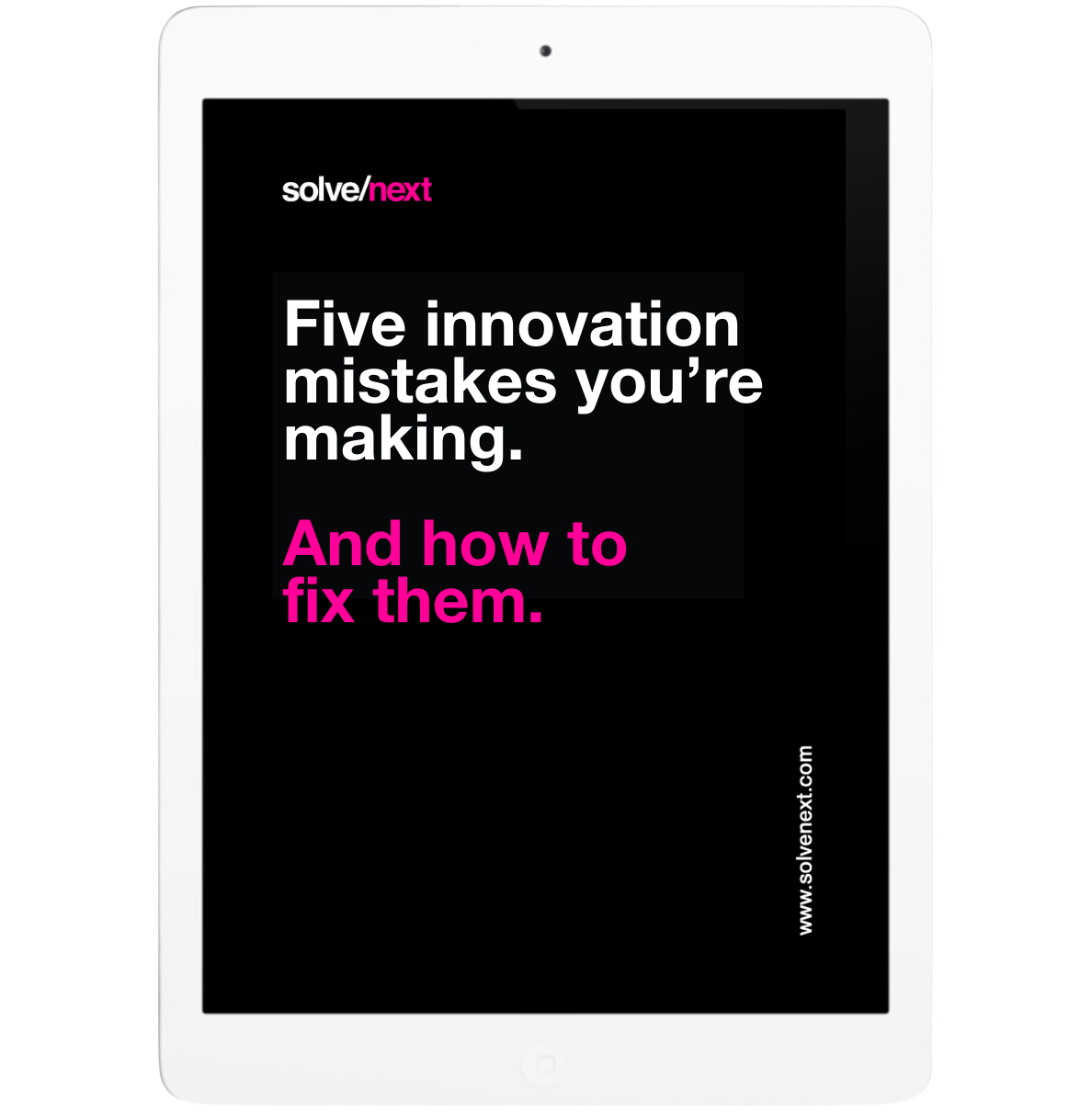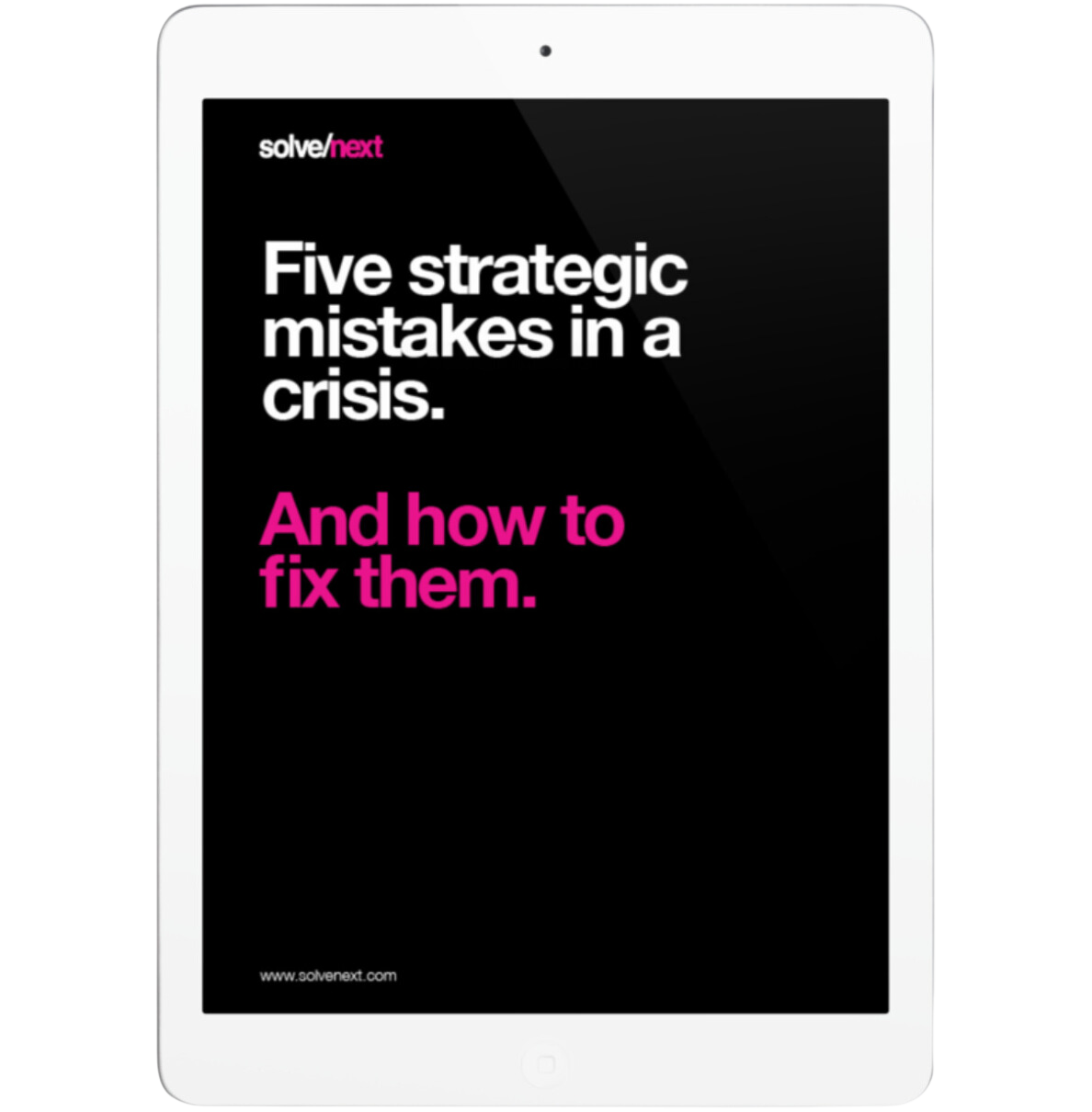Make next happen.
Ideas, articles, and inspiration.
Enjoy recent articles, podcasts, and thinking from the Solve Next team.
Free resources
Ebooks
Ebook: The six dimensions of Serious Capital.
Are your strategic investments draining resources and stifling innovation potential? It’s time to rethink how you evaluate opportunities. This isn’t just another guide to business growth—it’s a call to redefine success.
Ebook: More than money.
Financial capital fuels operations—but it can’t buy resilience, innovation, or trust on its own. Today’s leaders need six “serious capitals”.
Discover how blending all six builds a stronger, future‑proof organization.
Ebook: Five innovation mistakes—
And how to fix them.
Discover five innovation mistakes you just might be making. And what you can do about it.
Learn how innovation leaders have turned things around and put their organizations solidly on the path to innovation productivity.
Ebook: Five strategic mistakes in a crisis—And how to fix them.
Uncertainty can derail even the strongest organizations—but it doesn’t have to. Learn how to avoid the five most common strategic mistakes leaders make during a crisis and discover actionable steps to protect your capital, drive innovation, and emerge stronger.
Get your free ebook now
Ebook: The innovation multiplier.
How one strategic investment strengthens six forms of capital.
A blueprint for visionary leaders navigating complexity. Learn how to wield Political Capital to unlock Social, Reputational, Intellectual, Human, and Financial Capital—and create exponential impact.
Book: Think Wrong.
Topseller—over 10,000 copies sold.
“Finally: a self-help book that has recommendations besides writing goals, meditating and keeping a positive attitude. And it’s not just self-help—Think Wrong supplies concrete workshop instructions and suggestions to give you the tools to bring an entire team together…” —Amazon review
More resources
Solve Next AI Assistants: Smart Tools for Intelligent Innovation
Designed as part of Solve Next’s Intelligent System of Innovation, these AI Assistants help leaders evaluate, prioritize, and test opportunities with precision. From assessing Serious Capital to optimizing innovation portfolios, turn uncertainty into strategic action.
Is your organization ready to innovate? Take the readiness assessment
Discover the strengths and gaps in your innovation strategy. This Innovation Readiness Assessment evaluates your organization’s ability to drive and sustain innovation, providing insights to build a robust system for lasting impact.
Featured content
Next Moves with AI
Podcast
Next Moves with AI is a special series from Make Next Happen exploring how AI helps leaders drive smarter, faster innovation. Each episode introduces an AI Assistant from our Intelligent Innovation System—tools that tackle real-world challenges and offer practical ways to act today. If you’re ready to move beyond ad-hoc innovation, this series is your next move.
Explore why traditional innovation is failing and how organizations can replace high-risk bets with structured small bets to maximize learning, minimize risk, and drive real business value. They introduce the Intelligent Innovation System, built on People, Process, and Platform, and explain how the Small Bets Builder—AI Assistant helps teams identify Super Vital Assumptions (SVAs), design low-risk experiments, and track Learning From Investment (LFI).
This episode unpacks strategies for aligning short-term efficiency with long-term innovation using tools like the Next System and AI-driven decision-making frameworks. Learn actionable insights from the successes of Medellín's transformation and the failures of Sears to understand how disciplined innovation can drive sustainable growth. Leaders will gain key takeaways for navigating today's performance-focused environment using validated, scalable solutions.
Videos and webinars
Breaking the Status Quo: How to Lead Bold Change and Overcome Resistance
Change is hard—not because people resist, but because of ingrained habits and cultural norms. In this episode, Greg explores how to break predictable patterns, challenge assumptions, and build systems that drive real transformation. Learn how to lead bold change effectively.
Think Wrong to Accelerate Your Business Success
Greg Galle discusses how to tackle challenges with a unique problem-solving methodology that encourages bold, unconventional thinking, emphasizing the importance of collaboration, quick iteration, and moving from abstract ideas to tangible solutions.
Guest appearances
Unlocking Innovation: A Deep Dive with Greg Galle
In this thought-provoking conversation, Greg Galle, co-founder of Solve Next, explores the power of Systems of Innovation—why organizations struggle with it, how to unlock ingenuity, and how to build repeatable systems that drive real impact. From Think Wrong methodologies to the human side of problem-solving, this discussion is packed with insights for leaders, innovators, and change-makers.
Jumping the Ingenuity Gap: Greg Galle at TEDxGrandRapids:
Traditional thinking keeps us stuck in predictable outcomes. In this TEDx talk, Greg challenges the status quo and shares how thinking wrong can help us break assumptions, spark creativity, and drive real change. Discover how to ignite groundbreaking ideas that drive real change.
Innovate with Think Wrong (Spanish): Daniel at TEDxTalks
Daniel wants the developing world to be ble to innovate like they do in rich countries, innovation is the key to development, he proposes having formal innovation systems. He is the director of global expansion at Solve Next. In the future, he wants to create an educational model that trains leaders through technology and community service methodologies.
Thinking Wrong with Greg Galle at NavalXConnecx
Galle shares a number of innovative tools and techniques that he uses with his clients and group demonstrations from thinking wrong to letting go of unconscious biases and even encouraging other to being a little (intentionally) stupid.
Changing Business Culture for GOOD
Greg Galle, this week’s C-Change guest, with over 30 years of experience in leadership and problem-solving, co-founded a cloud-based system that empowers individuals and organizations to innovate by embracing unconventional thinking.




















In this episode, we challenge the traditional focus on financial capital and explore the power of serious capital, the kind that truly drives value and impact.
Rethinking Capital: Beyond the Financial Dimension
Beyond Money: Exploring the Multidimensional Nature of Capital
In a thought-provoking conversation on the evolution of capital, this podcast episode challenges the traditional focus on financial capital and explores the power of serious capital, the kind that truly drives value and impact. Greg Galle, Solve Next’s CEO, introduces the concept of “Serious Capital” — a more robust and multifaceted approach to value creation that transcends mere financial metrics.
From Silly to Serious: A New Paradigm in Capital
The episode kicks off with a compelling anecdote about Muhammed Yunus, the Nobel Prize-winning founder of the Grameen Bank, illustrating that some of the most transformative organizations think beyond financial gains to foster social capital. This sets the stage for a discussion about "Silly” versus “Serious” Capital, where "Silly Capital" refers to a narrow focus on financial outcomes that often leads to fragile solutions. Greg argues that true innovation requires a broader lens, considering five other forms of capital: social, intellectual, human, political, and reputational capital.
Expanding the Framework: Six Forms of Capital
Greg introduces listeners to six forms of capital that organizations should consider:
Human Capital: Impact on people and skills development.
Intellectual Capital: Proprietary knowledge and innovations.
Political Capital: Ability to influence policy and regulation.
Reputational Capital: Brand strength and credibility.
Social Capital: Community ties and societal impact.
Financial Capital: Traditional monetary assets.
Each type is discussed in the context of its relevance and potential for driving sustainable, long-term success. For example, Greg highlights how companies like Patagonia have invested in environmental and social capital, which in turn enhances their financial outcomes through increased consumer loyalty and brand strength.
Practical Insights: Applying the Serious Capital Framework
The conversation also offers practical advice on how organizations can shift from a myopic focus on financial results to a more holistic view of capital. Greg suggests starting with a structured framework to redefine organizational goals and strategies. He emphasizes the importance of experimenting with this model on a small scale to gather evidence and gradually persuade stakeholders of its efficacy.
Engaging All Sectors: The Role of Every Stakeholder
Importantly, the podcast addresses how individuals across different organizational roles can contribute to this expanded capital framework. From HR professionals focusing on human capital to PR teams building political and reputational capital, the discussion underscores the importance of each department in enhancing the overall value creation process.
The Worth It Tool
The Worth It Tool, by Solve Next, helps executives and innovation leaders assess and prioritize these diverse forms of capital within their projects and innovation opportunities. It is designed to help Leaders of Next navigate the complexities of capital allocation efficiently.
Through a straightforward process, the tool allows leaders to examine the six-dimensional impact of their assumptions, providing a clearer understanding and validation of strategic decisions that balance immediate gains with long-term benefits.
This structured approach aligns with strategic goals and ensures that every form of capital is optimized to contribute to the organization’s sustainable success.
Want to learn more about our Worth It tool?
Check it out here or book a demo.